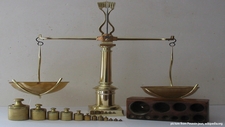Using a Balance

TEKS Objective
The student is expected to collect, record, and analyze information using tools, including microscopes, cameras, computers, hand lenses, metric rulers, Celsius thermometers, wind vanes, rain gauges, pan balances, graduated cylinders, beakers, spring scales, hot plates, meter sticks, compasses, magnets, collecting nets, notebooks, sound recorders, and Sun, Earth, and Moon system models; timing devices, including clocks and stopwatches; and materials to support observation of habitats of organisms such as terrariums and aquariums.
Essential Understanding
The student knows how to use a variety of tools and methods to conduct science inquiry.
Science Background
Mass vs. Weight: NASA (video) – Build your own understanding of the difference between “mass” and “weight,” with this video produced on the International Space Station.
Mass vs. Weight
NASA, education.ssc.nasa.gov
Tools and Equipment of Science: BioEd Online (video) - Barbara Tharp, MS, explains what types of tools are used in the elementary classroom and how to introduce the proper usage of tools to students.
Tools and Equipment of Science
BioEd Online, www.bioedonline.org
Signature Lesson
What Does a Pan Balance Tell Us About the Weight Order of the Cubes? The Inquiry Project (website) - In this second of a four-lesson unit on weight, students use a pan balance to order and compare cubes by weight.
- Supporting Lessons
- Extensions
- Assessment Ideas
- Literature Connections
- Related
TEKS - Additional Resources
Supporting Lessons
How Much Does It Weigh? Vermillion Parish School District (website) – Solid and liquids are measured and compared using a pan balance.
How Much Does It Weigh?
Vermillion Parish School District, www.vrml.k12.la.us
Elaboration Lessons and Extensions
The Weight of Things: The National Council of Mathematics Teachers (website) - Students use a pan balance to weigh pairs of objects and record their data.
The Weight of Things
The National Council of Mathematics Teachers, illuminations.nctm.org
Assessment Ideas
Have students bring 5 objects from home and rank their mass by measuring them with a pan balance.
Literature Connections
Millions to Measure, Schwartz, D. (ISBN-13: 978-0688129163)
Weighing the Elephant, Ting-xing, Ye (ISBN-13: 978-1550375275)
Additional Resources
Cyber Chase Poddle Weigh In: PBS Kids (website) – This interactive game challenges student to determine the mass of different creatures called poddles.
TEKS Navigation
Grade 3
Need Assistance?
If you need help or have a question please use the links below to help resolve your problem.

Comments